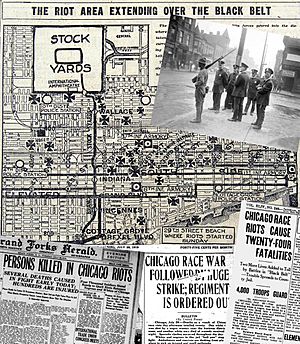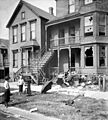Chicago race riot of 1919 facts for kids
| Part of the Red Summer and the Nadir of American race relations | |

Five police officers and a National Guard soldier with a rifle and bayonet standing on a corner in the Douglas neighborhood
|
|
| Date | July 27 – August 3, 1919 |
|---|---|
| Location | Chicago, United States |
| Deaths | 38 |
The Chicago race riot of 1919 was a serious and violent conflict. It happened between white and black Americans in Chicago, Illinois. The riot started on July 27 and lasted until August 3, 1919. During this week, 38 people died. Many more were hurt, and about 1,000 to 2,000 people, mostly black, lost their homes.
This event was one of the worst riots during a time known as the "Red Summer" of 1919. This summer saw many racial and labor conflicts across the United States. The Chicago riot was especially bad because it lasted a long time and had a big impact on the city's economy. It is remembered as one of the most difficult times in the history of Illinois.
Contents
What Caused the Riot?
In the early 1900s, many African Americans moved from the Southern United States to northern cities like Chicago. This movement was called the Great Migration. They came looking for better jobs and opportunities. Many settled on Chicago's South Side, near factories and meatpacking plants.
This led to new tensions in the city. Different groups, including European immigrants and Irish Americans, were already living there. They felt their jobs and neighborhoods were being threatened. Racism was common, and there was tough competition for jobs and housing. After World War I, these problems grew even worse. African American soldiers returning from the war were also more determined to fight against unfair treatment.
How the Riot Started
The riot began during a hot summer week. A 17-year-old African American boy named Eugene Williams was swimming in Lake Michigan. He accidentally drifted into a part of the beach that was unofficially set aside for white swimmers. This area was near 29th Street.
When white swimmers saw him, a conflict started. Eugene Williams was hit by a thrown stone and drowned. This event sparked widespread anger and violence.
The Riot Spreads
After Eugene Williams' death, violence quickly spread across Chicago. White mobs attacked black residents in their neighborhoods. Black people trying to get to or from work were also attacked. Some black citizens organized to protect themselves and their communities.
The Chicago Police Department often did not help. Sometimes, they even made things worse. The mayor of Chicago, William Hale Thompson, and the governor of Illinois, Frank Orren Lowden, disagreed on how to handle the situation. Mayor Thompson waited four days before asking the governor to send in the Illinois Army National Guard. This delay likely made the riot worse.
What Happened After the Riot?
After the riot ended, Governor Lowden created a special group. It was called the Chicago Commission on Race Relations. This group included both white and black members. Their job was to study why the riot happened and suggest ways to improve race relations. They published their findings in a book called The Negro in Chicago in 1922.
The riot also caused parts of Chicago's economy to shut down. Factories and businesses closed to prevent more conflicts between groups. The events of the riot influenced later political elections in Chicago. One of the biggest long-term effects was that both white and black communities started to live more separately from each other.
Remembering the Riot
People have found ways to remember the Chicago race riot and its victims:
- In 2019, an art performance called "Float" honored Eugene Williams. It involved people floating in the water near a Chicago beach.
- A large stone with a plaque was placed near 29th Street in 2009. It marks the location where the riot began.
- The Chicago Race Riots Commemoration Project started in 2019. It plans to put up 38 markers around the South Side. Each marker will remember one of the 38 lives lost.
- In 2021, a grave marker was placed at Eugene Williams' previously unmarked grave in Lincoln Cemetery.
Images for kids
-
African-American men in front of Walgreen Drugs (now called Walgreens) at 35th and S. State St. in the Douglas community area
See also
 In Spanish: Disturbios raciales de Chicago de 1919 para niños
In Spanish: Disturbios raciales de Chicago de 1919 para niños





